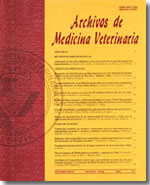Phenotypic, environmental and genetic parameters and trend estimation for milk production traits in Overo Colorado cattle
Main Article Content
Abstract
Chile has several cattle breeds that were brought from Europe which have developed adaptation traits some of them non-existing in more specialized breeds. The Overo Colorado (red and white) breed was introduced in Chile in the 19th century. Genetic improvement of the breed has been done via importation of frozen semen and mass selection. Although the breed is defined as dual purpose: milk and beef, selection emphasis heavily relies on the breeders personal preference. The breeders association was formed in 1944; however, the Overo Colorado breed is not genetically evaluated for production or conformation traits. The objectives of this study were 1) to create a data set to begin genetic evaluation of the breed, 2) estimate phenotypic and genetic parameters of milk traits, 3) to estimate phenotypic, environmental, and genetic trends of milk traits. Data were obtained from 16 herds; 9.455 lactations from 3.303 cows calving between years 1986 and 2001 were analyzed. The model included the fixed effect of herd-year-season, parity number and milk recording agency. Animal genetic and permanent environmental effects were treated as random. Variance components were estimated by Restricted Maximum Likelihood (REML). Phenotypic 305 days average milk and fat yield were 5.044 and 177 kilograms, respectively. Fat and protein percentages were 3.51 and 3.25, respectively. Phenotypic and environmental trends for milk and fat yield were estimated at 82.02, 3.45, 73.97 and 3.10 kg per year, respectively. Phenotypic and environmental trends for fat and protein concentration were .087, .37, .05 and .26 grams/liter per year, respectively; the last three being non different from zero. Heritability and repeatability for milk and fat yield were estimated at .25, .50, .23 and .46, respectively. Heritability and repeatability for fat and protein percentage were estimated at .44, .56, .43 and .59, respectively. Genetic trends for milk and fat yield were 1.91 and .065 kilograms per year, respectively; the later being non different from zero. Genetic trends for fat and protein concentration were -.013 and .017 grams/liter per year, respectively.

